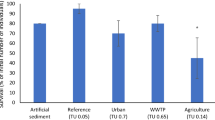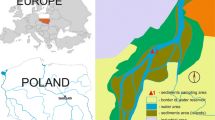Abstract
Biological response could not be predicted based on chemical concentration of the sediment contaminants. Bioassays integrate the response of test organisms to contaminants and nutrients. Comparative results of five acute bioassays indicated that Neubauer phytoassay was the most sensitive. The microbial biomass and algal growth tests indicated a response to the availability of contaminants and nutrients. These results suggest the usefulness of a diversity of bioassays in toxicity testing of sediment contamination.
Similar content being viewed by others
References
Ahlf, W., 1985. Behaviour of sediment-bound heavy metals in a bioassay with algae: Bioaccumulation and toxicity. Vom Wasser 65: 183–188.
Ahlf, W., 1988. Correlations between chemical and biological evaluation procedures for the determination of heavy metal availability from soils. In: K. Wolf, W. J. van den Brink & F. J. Colon (Eds.), Contaminated Soil '88 pp. 67–69. Kluwer Academic Publishers Dordrecht.
Ahlf, W. & M. Munawar, 1988. Biological assessment of environmental impact of dredged material. In: W. Salomons & U. Förstner (Eds.), Chemistry and Biology of Solid Waste, pp. 127–142. Springer Verlag, Heidelberg.
Benndorf, A., J. Benndorf, W. Horn & W. Stelzer, 1977. Biochemische Charakteristika des Sestons. Acta Hydrochim. Hydrobiol. 5: 33–42.
Dutka, B. J. & G. Bitton, 1986 (Eds.). Toxicity Testing Using Microorganisms. Vol. 2 CRC Press, Boca Raton, Fla. pp. 186.
Hoke, R. A. & B. L. Prater, 1980. Relationship of percent mortality of four species of aquatic biota from 96-hour sediment bioassays of five Lake Michigan harbors and elutriate chemistry of the sediments. Bull. envir. Contam. Toxicol. 25: 394–399.
Keeley, J. W. & R. M. Engler, 1974. Discussion of regulatory criteria for ocean disposal of dredged materials; Elutriate test rationale and implementation guidelines. U.S. Army Corps of Engineers, DMRP, Vicksburg, Miss. Technical Report D-74–14. pp. 39.
Liu, D. & G. W. Strachan, 1981. A field method for determining the chemical and biological activity of sediments. Wat. Res. 15: 353–359.
Lohse, J., 1988. Ocean incineration of toxic wastes: A footprint in North Sea sediments. Mar. Pollut. Bull. 19(8): 366–371.
Marshner, H., V. Römheld, W. J. Horst & P. Martin, 1986. Root-induced changes in the rhizosphere: Importance for the mineral nutrition of plants. Z. Pflanzenernaehr. Bodenk. 149: 441–456.
Miller, W. E., J. C. Greene & T. Shiroyama, 1978. The Selenastrum capricornutum Printz. algal assay bottle test: Experimental design application, and data interpretation protocol. EPA 600/9–78–018, U.S. Environmental Protection Agency, Corvallis OR.
Miller, W. E., S. A. Peterson, J. C. Greene & C. A. Callahan, 1985. Comparative toxicology of laboratory organisms for assessing hazardous waste sites. J. Envir. Qual. 14: 569–574.
Munawar, M. & I. F. Munawar, 1987. Phytoplankton bioassays for evaluating toxicity of in situ sediment contaminants. In: R. L. Thomas, R. Evans, A. Hamilton, M. Munawar, T. Reynoldsen & H. Sadar (Eds.) Ecological effects of in situ sediment contaminants. Hydrobiologia. 149: 87–105.
Ongley, E. D., D. A. Birkholz, J. H. Carey & M. R. Samoiloff, 1988. Is water a relevant sampling medium for toxic chemicals? An alternative environmental sensing strategy. J. Envir. Qual. 17: 391–401.
Thomas, J. M. & J. F. Cline, 1985. Modification of the Neubauer technique to assess toxicity of hazardous chemicals in soils. Envir. Toxicol. Chem. 4: 201–207.
Williams, L. G., P. M. Chapman & T. C. Ginn, 1986. A comparative evaluation of marine sediment toxicity using bacterial luminescence, oyster embryo and amphipod sediment bioassays. Mar. Envir. Res. 19: 225–249.
Author information
Authors and Affiliations
Rights and permissions
About this article
Cite this article
Ahlf, W., Calmano, W., Erhard, J. et al. Comparison of five bioassay techniques for assessing sediment-bound contaminants. Hydrobiologia 188, 285–289 (1989). https://doi.org/10.1007/BF00027794
Issue Date:
DOI: https://doi.org/10.1007/BF00027794




